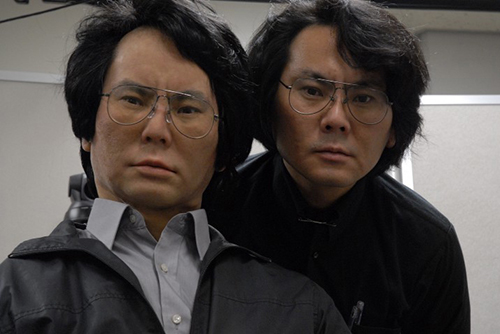

Geminoid™ HI-4: Osaka University
Autonomous driving and androids are both new technologies. Can humans accept new technology without resistance? Professor Ishiguro, a leading expert in robotics engineering, spends his time thinking about how people will accept new technologies and shared his thoughts with us.
Geminoid™ HI-1 : ATR Hiroshi Ishiguro Laboratories
Q: How do you think people will react to new technologies coming out, such as the androids that you are researching?
People will have to learn how to use new tools and machines, so they may initially be reluctant. However, this is something that has been repeated throughout history. In addition, people will feel less resistance toward the newer technology. That is because the new technology is more human-like.
For example, if it has the ability to operate things through voice recognition, there will be no need to read the instructions, right? Technology will be more and more human-like, hence making it easier for people to use. Therefore, people will embrace it immediately. When you compare learning how to use a PC with learning how to use a smartphone, the interface on a smartphone is more creative. In other words, technology will be much easier to utilize.
Feeling resistance as a user, and society being resistant to accepting technology, are separate issues. In 10 or 20 years, voice recognition will evolve, allowing a more human-like interaction and use through speech. No one will feel resistance toward something like this. Resistance toward technology is something totally different and depends on your perspective.
Q: With autonomous driving, it takes courage to leave the driving up to technology. Wouldn’t there be a lot of people who would hesitate to use autonomous driving?
I don’t think so. Think about getting your driver’s license. Would you rather learn to drive and get a driver’s license, or would you rather just choose autonomous driving? Nowadays, people choose to get a license to drive automatic transmissions. When I got my license, I learned to drive with manual transmission, so I was afraid to drive a car with automatic transmission. However, these days, people prefer automatic transmission.
If it is suggested that it would be better to have cruise control, then that function would become available by default. If you ask people if they prefer to acquire driving skills themselves or have something with technology drive for them, obviously people would choose the latter.

Geminoid™ HI-1 : ATR Hiroshi Ishiguro Laboratories
Q: How do you plan to gain recognition of the social value of robots?
I think it is important to simply make robots more widespread. They have to be designed so that they can be utilized in different ways by using various software. This is a capability available to PCs and smartphones, but it has not yet been realized in robots. Powerful applications that can only be used by robots will need to be designed, and with this at their core, robots should become more widespread globally. I think it is only a matter of time before this kind of content becomes available.
Q: So does that mean it must first be introduced to the masses?
I think there are two patterns here, and one would be to make it available for the masses, and the other for specific purposes. Meaning, niches where people are willing to spend any amount of money out of necessity, or where there is a problem that needs to be solved. For example, there are some patients with autism or dementia that can only converse with robots, so one way would be to start with specific purposes, such as in the medical field. There are two more ways, such as making them usable by everyone through gaming consoles, smartphones and PCs, so that people can enjoy them as different games, or suddenly just making them available at once as an infrastructure.

Geminoid™ HI-2 : ATR Hiroshi Ishiguro Laboratories
Q: How do you envision the future of society as a whole 10 or 20 years from now?
It is possible that a humanoid communication robot could be popularized in two to three years. No one can predict what will happen for sure. There was a strong necessity for automobiles and refrigerators, so they were created as products. However, there is no such necessity for robots. Society will need to adapt to new technology as well, so there is a need to introduce something that is easily adaptable. Put simply, more human-like technology may be rapidly adopted. This just means older technology will be replaced with something that people can feel more affinity toward. Like the difference between the iPhone and old-school cell phones.
The same goes for cars. If autonomous cars only had the ability to take a person from one place to another, I don’t think it would change the world. Like I mentioned earlier, if the idea is to create a partner, unless it makes life fun, even in rural areas the experience would not be like the time when people switched over from cell phones to iPhones. Human brains are wired to accept something that looks human. Our hearing abilities allow us to pick up human voices, and with vision, we have many cells that respond to human-like faces. Since all human brains are made for human beings, everything made to be accepted by people will become a more intricate part of their lives.
# # #